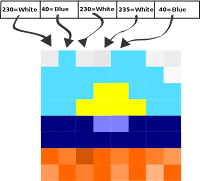File compression
 is commonly used when sending a file from a computer to another over a connection that has limited bandwidth. The compression basically makes the file smaller and, therefore, the sending of the file is so fast. Of course, when compressing a file and sending it to another computer that computer has to have a program that will decompress the file so it can be returned to "normal" and used.
is commonly used when sending a file from a computer to another over a connection that has limited bandwidth. The compression basically makes the file smaller and, therefore, the sending of the file is so fast. Of course, when compressing a file and sending it to another computer that computer has to have a program that will decompress the file so it can be returned to "normal" and used.A head crash
A head crash is a hard-disk failure that happened when a read–write head of a hard disk drive comes in contact with its rotating platter, resulting in permanent and usually fatal damage to the magnetic media on the platter surface. When this happens, you usually lose much of the data on the hard disk and will need to replace both the head and the disk. For this reason, it is so important to operate disk drives, particularly hard disk drives, in as clear environment as possible. Even smoke particles can cause a head crash.
Internet hard drive
The purpose of an Internet hard drive is to offer a means of accessing your computer files (pictures, documents, music, etc.) from any computer, as long as that computer has access to the Internet. Similar to depositing money into your bank account, and later withdrawing that same money from any ATM machine, an Internet hard drive will allow you to "deposit" your computer files into a remote hard drive, and then later access those very same files from any other computer.
Optical Disc Drive
An optical disc drive (ODD) is a disk drive that uses a kind of light or electromagnetic waves near the light spectrum as part of the process of reading or writing data to or from optical discs. Some drives can only read from discs, but recent drives are commonly both readers and recorders. Recorders are sometimes called burners or writers. Compact discs, DVDs, andBlu-ray discs are common types of optical media which can be read and recorded by such drives.
Solid state storage
integrated circuit devices to store data rather than moving magnetic or optical
media. SSS is typically non-volatile and may take various forms, such as a solid
state drive, solid state card or solid state module. In addition, SSS includes
PATA
(legacy), SATA, SAS, Fibre Channel or PCIe interface options.




































